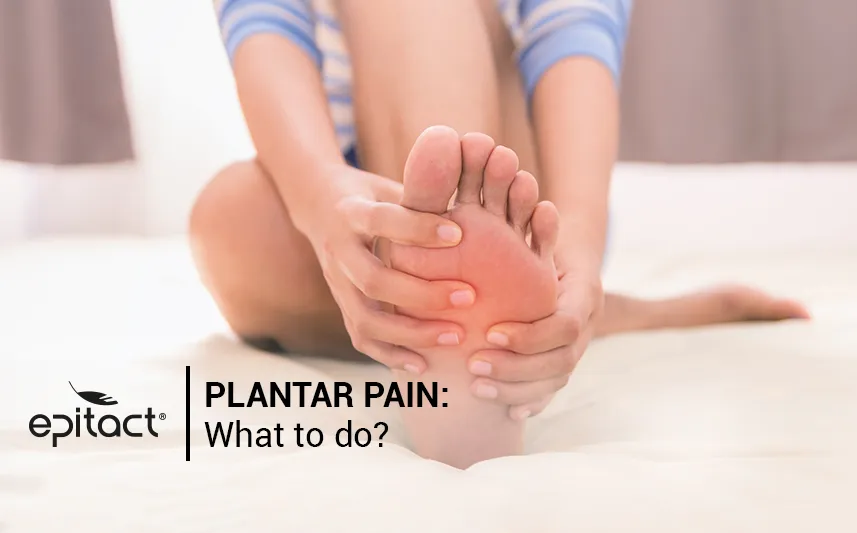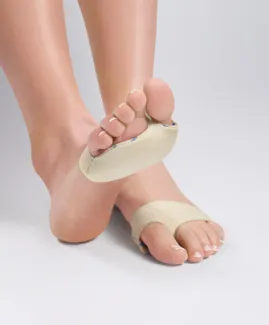
Many of us have already suffered pain in the ball of the foot when walking. A painful ball of foot pain reduces the mobility or makes walking difficult. You wonder what to do for ball of foot pain? With EPITACT®, discover the causes and solutions to feel comfortable in your shoes!
How to relieve pain in the ball of the foot when walking?
Firstly, let’s understand what a ball of foot pain is and what causes it. Then, discover our solutions to relieve it in your shoes and fully enjoy your day!
What is a ball of foot pain?
Ball of the foot pain refers to a pain located in the metatarsal region, usually on the plantar surface, i.e. the inferior part in contact with the ground.
The full body weight rests on this small area which is particularly used, especially when walking or wearing high heels. Indeed, wearing shoes with a poor-quality insole does not cushion the foot sufficiently. Over repetitive steps and excessive weight, it can create real discomfort. In addition, high heels often cause pain in the ball of the foot because pressure increases even more on the bottom of the forefoot.
A pain felt on this part can destabilise or imply compensations affecting other joints over time. Then, it is necessary to take care of your feet and prevent or treat any pain before.
Painful ball of the foot: causes
There are many causes of pain in the ball of the foot when walking or not. They can be related to muscles, bones, joints, ligaments, tendons or even nerves!
In order to identify the cause, observe all the symptoms carefully. Did you notice a lesion, redness, excrescence, swelling? Does foot pain occur during movement or does it persist at rest?
According to these symptoms and their intensity, different causes can be involved:
- Trauma: shock, wound, fracture or repeated friction may cause plantar pain.
- Deformity: hallux valgus, hammer or claw toes, flat or hollow foot arch; your feet are victims of a large number of deformities leading to acute pain in the ball of your foot when walking for example.
- Infection: plantar warts (papillomavirus infection) or the development of a fungal infection are both examples likely to cause pain.
- Inflammation: especially in the case of plantar fasciitis or tendinopathy.
- The metatarsal head syndrome or Morton's neuroma.
- Lastly, joint diseases such as osteoarthritis or arthritis can be responsible for pain on the sole of the foot.
Most of the time, a pain in the ball of the foot when walking is just related to prolonged and repeated pressure under the forefoot. Sometimes, those stresses cause the formation of a plantar callus, which may cause ball of the foot pain when you’re walking. In such a case, EPITACT® offers you an easy to use and daily protection for relieving you!
What to do for ball of foot pain when walking?
Although the causes are different and treatments are to be adapted to each person, the general behaviours in the case of a painful ball of the foot are protection and relief. Losing weight and wearing shoes with a wide toe box are also important. In addition, you can see an orthopaedist who can make you shoe insoles for fallen or high arches support, if needed.
If you have pain in the ball of your foot when you walk, the EPITACT® silicone metatarsal pads* are recommended. They reduce the friction and distribute the pressure better under the forefoot. They aim to strengthen the plantar fat pad to distribute pressures better. Indeed, they have the same properties as the natural plantar fat pad. In addition, they are very thin so you can wear them in any type of shoes in order to relieve your ball of foot pain!
If you have a foot deformity like a bunion that is the origin of your pain in the ball of your foot when walking, find out the flexible bunion corrector* that protects your big toe from friction and pressure and prevents the formation of calluses under the forefoot. Read the next articles for more information about the symptoms of metatarsalgia or the prevention and reduction of calluses.
*These solutions are class I medical devices that bear the CE marking under this regulation. Carefully read the instructions before use. Manufacturer: Millet Innovation. 03/2022
 Pharmacie
Pharmacie
